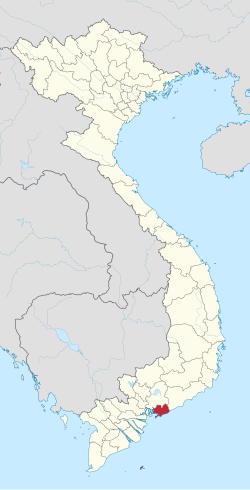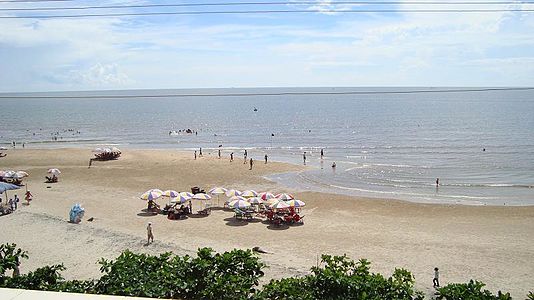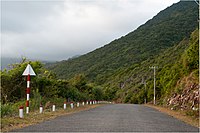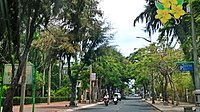Province in Southeast, Vietnam
| Bà Rịa – Vũng Tàu Phước Tuy | |
|---|---|
| Province | |
| Bà Rịa - Vũng Tàu province | |
 Hồ Cốc Beach Hồ Cốc Beach | |
 Flag Flag Seal Seal | |
| Nickname: A Place to Dock Boats | |
 Location of Bà Rịa–Vũng Tàu within Vietnam Location of Bà Rịa–Vũng Tàu within Vietnam | |
  | |
| Coordinates: 10°35′N 107°15′E / 10.583°N 107.250°E / 10.583; 107.250 | |
| Country | |
| Region | Southeast |
| Metropolitan area | Ho Chi Minh City metropolitan area |
| Capital | Bà Rịa |
| Former seat | Vũng Tàu (until 2 May 2012) |
| Government | |
| • People's Council Chair | Nguyễn Hồng Lĩnh |
| • People's Committee Chair | Nguyễn Thành Long |
| • Secretary of Bà Rịa–Vũng Tàu Party Committee | Nguyễn Hồng Lĩnh |
| Area | |
| • Total | 1,982.56 km (765.47 sq mi) |
| Population | |
| • Total | 1,187,500 |
| • Density | 600/km (1,600/sq mi) |
| Demographics | |
| • Ethnic groups | 97.53% Vietnamese Other minorities |
| GDP | |
| • Total | VND 366.456 trillion US$ 15.250 billion (2023) |
| Time zone | UTC+7 (ICT) |
| Area codes | 64 (until 16 July 2017) 254 (from 17 June 2017) |
| ISO 3166 code | VN-43 |
| HDI (2022) | (1st) |
| Website | Baria-Vungtau.gov.vn Baria-Vungtau.dcs.vn |
Bà Rịa–Vũng Tàu (abbreviated BRVT) is a province of Vietnam. It is located on the coast of the country's Southeast region. It also includes the Côn Đảo islands, located some distance off Vietnam's southeastern coast. From 1954 to 1975, under South Vietnam, the province was called Phước Tuy.
History

With the exception of the Côn Đảo islands, all of Bà Rịa–Vũng Tàu province was once a part of Đồng Nai province to the north. In 1979, Vũng Tàu was separated from Đồng Nai and merged with the Côn Đảo islands (formerly part of Hậu Giang province), forming the new Vũng Tàu-Côn Đảo "special zone". Later, in 1992, Bà Rịa broke away from Đồng Nai Province, merging with Vũng Tàu-Côn Đảo to form the modern province of Bà Rịa–Vũng Tàu.
Climate
Further information: Vũng Tàu § Climate, and Côn Sơn Island § ClimateThe province has a tropical monsoon climate with two distinct seasons: a rainy season from May to October, and a dry season from November to April. The average annual temperature is 27 °C (81 °F), ranging from an average monthly temperature of 24.8 °C (76.6 °F) to an average monthly temperature of 28.6 °C (83.5 °F). The province receives 2,400 hours of sunshine per year while it receives an annual precipitation of 1,500 mm (59 in).
Administrative divisions
Bà Rịa–Vũng Tàu is subdivided into eight district-level sub-divisions:
- Five districts:
- Three provincial cities:
They are further subdivided into six commune-level towns (or townlets), 47 communes, and 29 wards.
| District-level sub-divisions | Bà Rịa City |
Vũng Tàu City |
Phú Mỹ City |
Châu Đức District |
Côn Đảo District |
Đất Đỏ District |
Long Điền District |
Xuyên Mộc District | |||||
|---|---|---|---|---|---|---|---|---|---|---|---|---|---|
| Area (km) | 91.5 | 141.1 | 333.84 | 422.6 | 76 | 189.6 | 77 | 640.9 | |||||
| Population | 205,192 | 527,025 | 221,030 | 143,306 | 8,360 | 76,659 | 140,485 | 162,356 | |||||
| Density (people/km) | 1,338 | 3,635 | 720 | 339 | 110 | 404 | 1,825 | 253 | |||||
| Administrative divisions | 8 wards, 3 communes | 16 wards, 1 communes | 5 wards, 5 communes | 1 townlet, 15 communes | 16 islands | 2 townlets, 6 communes | 2 townlets, 5 communes | 1 townlets, 12 communes | |||||
| Year of establishment | 2012 | 1992 | 2018 | 1994 | 1991 | 2003 | 2003 | 1976 | |||||
| Source: Website of Bà Rịa–Vũng Tàu Province | |||||||||||||
Demographics
| History of developing population | ||||||||||||||||
| Year | Population | |||||||||||||||
| 1995 | 708,900 | |||||||||||||||
| 1996 | 730,400 | |||||||||||||||
| 1997 | 752,700 | |||||||||||||||
| 1998 | 775,600 | |||||||||||||||
| 1999 | 805,100 | |||||||||||||||
| 2000 | 829,900 | |||||||||||||||
| 2001 | 858,000 | |||||||||||||||
| 2002 | 880,800 | |||||||||||||||
| 2003 | 899,100 | |||||||||||||||
| 2004 | 918,900 | |||||||||||||||
| 2005 | 938,800 | |||||||||||||||
| 2006 | 955,700 | |||||||||||||||
| 2007 | 970,200 | |||||||||||||||
| 2008 | 983,600 | |||||||||||||||
| 2009 | 998,500 | |||||||||||||||
| 2010 | 1,012,000 | |||||||||||||||
| 2011 | 1,027,200 | |||||||||||||||
| 2017 | 1,098,794 | |||||||||||||||
| 2019 | 1,148,313 | |||||||||||||||
| Source: | ||||||||||||||||
According to 2015 statistics from the General Statistics Office of Vietnam, the province has a population of 1,072,600. Urbanization in the province is above the country's average (50.52%).
Economy
Bà Rịa–Vũng Tàu provincial economic activities include: petroleum (the most important), electricity at the Phú Mỹ Power Plants and Bà Rịa Power Plant (accounting for approx. 40% of the country's total power capacity), petrochemicals: Phú Mỹ Urea Plant (800,000 metric tonnes per year), polyethylene (100,000 metric tonnes per year), steel production, and cement production. Tourism, commerce and fishing are also important economic activities of the province. Bà Rịa–Vũng Tàu contributes greatly to the country's budget. In 2005, it accounted for around 24 percent of Vietnam's budget (42,000 billion dong) of a total of 180,000 billion dong (exchange rate is 16,000 dong/dollar), ranking second, after Ho Chi Minh City before Hanoi (28,000 billion dong in 2005). The provincial GDP per capita ranks second to none in the country, over $4,000, if excluding petroleum GDP, it is over $2,000 (Hồ Chí Minh City ranks second with this index $1,850). In terms of living standards, Bà Rịa–Vũng Tàu ranks third, behind Hồ Chí Minh City and Hanoi.
Bà Rịa–Vũng Tàu is also one of the leading direct foreign investment (FDI) attractions of Vietnam, in the top five of FDI acquisition provinces of Vietnam. In tourism, there are some big projects licensed or to be licensed soon: Saigon Atlantis resort (capitalized US$300 million), Vũng Tàu Aquarium and Bàu Trũng entertainment park ($500), and Xuyên Mộc safari ($200).
On Vietnam's Provincial Competitiveness Index 2023, a key tool for evaluating the business environment in Vietnam’s provinces, Ba Ria-Vung Tau received a score of 69.57. This was a slight decrease from 2022 in which the province received a score of 70.26. In 2023, the province received its highest scores on the ‘law and order’ and ‘informal charges’ criteria and lowest on ‘business support policy’ and ‘labour policy’.
Tourism
Vũng Tàu is an important tourist destination, being particularly well known for its beaches, for its colonial-era architecture, and the Christ of Vũng Tàu, a large statue built by Vietnam's Catholic minority. It was completed in 1974, with the height of 32 metres and two outstretched arms spanning 18.4 metres. It is among the tallest statues of Christ in Asia. Among the most famous tourist destinations are the existing very popular and crowded beaches of Vũng Tàu and Long Hải and the new up and coming destinations of Hồ Tràm and Hồ Cốc located further along the South Sea coast. The main media agency in the province is the Bà Rịa–Vũng Tàu Daily Newspaper.
Determining tourism as one of the pillars of local socio-economic development, in early 2017, Bà Rịa–Vũng Tàu province decided to re-establish the Tourism Department. By the end of the year, the Bà Rịa–Vũng Tàu Provincial Party Committee had issued a resolution on developing high-quality tourism, which aimed to develop the tourism infrastructure and improve the quality of tourism products and services in the direction of modernity and difference, while ensuring a safe, civilized and friendly tourist environment. According to Trịnh Hàng, Director of the Tourism Department of Bà Rịa–Vũng Tàu province, since its establishment, the Tourism Department has advised the Provincial People's Committee on many plans such as the census of tourist accommodation establishments throughout the province, the plan on enhancing the management of tourist destinations, the plan on regulations to select tourism establishments with the title "Meeting the standards for tourist service", the plan on regulations to manage the beaches, and completing the master plan on tourist development of Bà Rịa–Vũng Tàu province by 2025, with a vision to 2030. With the efforts of the provincial tourism industry and local authorities, the image of Bà Rịa–Vũng Tàu tourism has created a positive impression for visitors. Many other visitors to Vũng Tàu at this time have also been impressed by the changes in the destination. Vũng Tàu tourism is very much regaining its prestige and class.
Infrastructure
BRVT serves as a major trade gateway for Vietnam due to its proximity to industrial zones, port complex, major highways, and transshipment routes. Infrastructure investments in the province have not only increased connectivity within the province but also with neighboring economic hubs such as Ho Chi Minh City and Đồng Nai province.
Ports
BRVT is a major gateway for international shipments in Southeast Asia, due to the Cai Mep–Thị Vải port complex. The port system ranks among the major ports in the region and one of only 19 in the world capable of handling 190,000 deadweight tonnage (DWT) vessels.
Container ships from this port complex are capable of transporting goods to Europe as well as North America. In addition, the province is also around 70 km from Ho Chi Minh City's Cát Lái port.
The government is also planning to increase investments in the development of terminals and road infrastructure to increase connectivity, efficiency, and port capacity.
Airports
The Tân Sơn Nhất International Airport in Ho Chi Minh City is less than 90 km from the province and around 70 km from the Cai Mep–Thị Vải port complex.
In addition, the new Long Thành International Airport which is under construction is only around 30 minutes from the port complex and 50 km from the province.
Highways
The province has access to major national highways such as National Highway 51 and National Highway 1. In addition, expressways such as Ho Chi Minh City – Long Thành – Dầu Giây Expressway, Biên Hòa - Vũng Tàu expressway, and Bến Lức - Long Thành highway (to open in 2020) further increase connectivity with the surrounding provinces.
Within the province, the connectivity between ports or industrial zones with the national roadway systems is supported by numerous regional highways, port roads, and industrial zone roads.
Industrial zones
As of August 2018, there are 15 industrial parks in BRVT, including nine which are operational with an average occupancy rate of 47 percent. There are currently 339 projects in local industrial parks, including 162 foreign and 177 domestic projects.
The locality is also home to two industrial parks that specialize in supporting industries, Phú Mỹ 3 and Đá Bạc.
International relations
Sister cities
This article is about sister cities/regions of Bà Rịa–Vũng Tàu province. For sister cities/regions of Vũng Tàu City, see Vũng Tàu.There are nine sister cities/regions of Bà Rịa–Vũng Tàu province:
| City/region | Since |
|---|---|
| 12 May 1997 | |
| 28 February 2000 | |
| 9 September 2000 | |
| 17 August 2004 | |
| 19 September 2007 | |
| 30 November 2009 | |
| 9 March 2010 | |
| 31 October 2010 | |
| 15 September 2012 |
Festivals
- Nghinh Co Festival at Dinh Cố Shrine (12th day of the second lunar month)
- Sea Festival
- The fair in this festival will also showcase products and promote cooperation between businesses in industry, agriculture, trade and services in the province and neighboring provinces. Several seminars and workshops on trade and tourism promotion, as well as environmental protection, will be organised
- International Kite Festival (held annually since 2009 in Vũng Tàu City)
Gallery
-
Vũng Tàu, the province's largest city
-
 Beach at Long Hải, a tourist attraction
Beach at Long Hải, a tourist attraction
-
 Port in Phú Mỹ, an industrial town
Port in Phú Mỹ, an industrial town
References
- Biểu số 4.5: Hiện trạng sử dụng đất vùng Đông Nam Bộ năm 2022 [Table 4.5: Current land use status in the Southeast region in 2022] (PDF) (Decision 3048/QĐ-BTNMT) (in Vietnamese). Ministry of Natural Resources and Environment (Vietnam). 18 October 2023. – the data in the report are in hectares, rounded to integers
- "Area, population and population density by province". General Statistics Office of Vietnam. Retrieved 30 September 2024. – Interactive table which you can view by making your selection in three boxes: (1) Cities, provinces: Select all; (2) Year: Select 2023; (3) Items: Select all.
- "Area and Population". Ba Ria–Vung Tau People's Committee. Archived from the original on 6 January 2017. Retrieved 5 January 2017.
- "BA RIA-VUNG TAU HAS AN IMPRESSIVE GROWTH IN 2023 THANKS TO DIERCE SOLUTIONS".
- "Human Development Index by province(*) by Cities, provincies and Year". General Statistics Office of Vietnam. Retrieved 28 September 2024.
- "History – Ba Ria". Vung Tau Portal. Retrieved 1 November 2019.
- "Natural Conditions – Ba Ria". Vung Tau Portal (in Vietnamese). Retrieved 1 November 2019.
- ^ Về việc thành lập thành phố Bà Rịa thuộc tỉnh Bà Rịa–Vũng Tàu, Trang Chính phủ.
- ^ Theo Nghị định 45-CP, văn bản bổ sung.
- Căn cứ Luật Tổ chức Chính phủ ngày 25 tháng 12 năm 2001, Theo Thư Viện Pháp Luật.
- Dân số Huyện Xuyên Mộc vào năm 2007 Archived 10 August 2020 at the Wayback Machine, Theo Công Đoàn Bà Rịa Vũng Tàu.
- Mít tinh kỷ niệm 20 năm thành lập – Vũng Tàu, Cổng thông tin thành phố Vũng Tàu.
- Dân số trung bình phân theo địa phương qua các năm, Theo Tổng cục thống kê Việt Nam.
- "Số liệu thống kê – Diện tích, dân số và mật độ" [Interractive statistics tables – Area, population and density] (in Vietnamese). General Statistics Office of Vietnam. Archived from the original (To access, click the desired location in column 1 (Địa phương), click "2015" in column 2 (Năm), and click the desired field in column 3 (Chỉ tiêu): click Diện tích for Area, Dân số for Population, and Mật độ dân số for Population density) on 11 January 2018. Retrieved 5 January 2017.
- "Diện tích và dân số" [Area and population] (in Vietnamese). Ba Ria–Vung Tau People's Committee. Archived from the original on 20 March 2017. Retrieved 5 January 2017.
- the-shiv (23 August 2024). "Doing Business in Ba Ria-Vung Tau, Vietnam 2024". the-shiv. Retrieved 24 August 2024.
- "vietnamtourism.gov.vn".
- "An Economic Overview of Ba Ria – Vung Tau province". Vietnam Briefing News. 21 February 2019. Retrieved 1 November 2019.
- "Danh sách các tổ chức, địa phương nước ngoài đã ký kết biên bản thoả thuận hợp tác với tỉnh Bà Rịa - Vũng Tàu". Sở Ngoại vụ tỉnh Bà Rịa - Vũng Tàu (in Vietnamese). 9 May 2018. Archived from the original on 26 December 2022. Retrieved 26 December 2022.
- Websoft.vn. "Festivals in Ba Ria – Vung Tau". Vietnamtourism (in Latin). Retrieved 1 November 2019.
- "Bà Rịa–Vũng Tàu Province's Sea Festival kicks off". vietnamnews.vn. 31 October 2019. Retrieved 1 November 2019.
External links
- Official website (in Vietnamese)
| Places adjacent to Bà Rịa–Vũng Tàu province | ||||||||||||||||
|---|---|---|---|---|---|---|---|---|---|---|---|---|---|---|---|---|
| ||||||||||||||||
| Subdivisions of Vietnam | |||||||||||||||||
|---|---|---|---|---|---|---|---|---|---|---|---|---|---|---|---|---|---|
| Municipalities |
| ||||||||||||||||
| Provinces |
| ||||||||||||||||
| Districts of Southeast Vietnam | ||
|---|---|---|
| Ho Chi Minh City |
|  |
| Bà Rịa–Vũng Tàu province | ||
| Bình Dương province |
| |
| Bình Phước province |
| |
| Đồng Nai province | ||
| Tây Ninh province |
| |
| denotes provincial seat | ||
| Ho Chi Minh City metropolitan area | |
|---|---|
| Core city | |
| Satellite provinces | |
| Category | |


